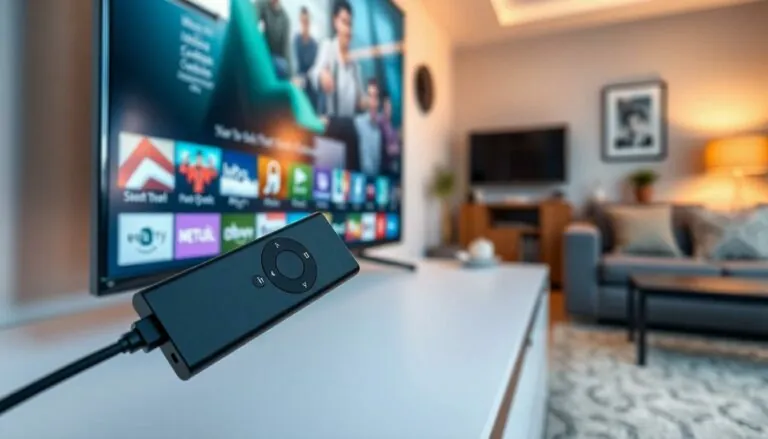In a world where gadgets seem to multiply faster than rabbits, consumer electronics brands are the wizards behind the curtain. They create everything from sleek smartphones to smart fridges that order groceries for you—because who has time for that? As technology evolves at lightning speed, these brands are in a constant race to outdo each other, leaving consumers both dazzled and a little dizzy.
Table of Contents
ToggleOverview of Consumer Electronics Brands
Consumer electronics brands play a crucial role in shaping modern technology trends. They develop innovative products that include smartphones, tablets, wearables, home appliances, and entertainment systems. Each brand contributes unique features to enhance user experience and functionality.
Companies like Apple, Samsung, and Sony lead the market with cutting-edge technology and distinct designs. Apple excels in user interface and ecosystem integration, while Samsung focuses on display quality and diverse product lines. Sony emphasizes high-quality audio and video products, catering to entertainment enthusiasts.
Emerging brands, such as Xiaomi and OnePlus, challenge established giants by offering high-quality products at competitive prices. They attract budget-conscious consumers without sacrificing performance. Design and functionality remain critical, with these brands prioritizing sleek aesthetics and robust features.
Sustainability has become a focal point for many brands. Companies invest in eco-friendly materials and practices to reduce environmental impact. LG and Philips exemplify this trend, launching energy-efficient appliances and recycling programs that resonate with environmentally aware consumers.
Brand loyalty persists in this competitive landscape. Consumers often choose brands based on past experiences and perceived reliability. User reviews and expert opinions influence decisions significantly, driving brands to continuously improve and innovate.
Innovation is not limited to new products alone. Many brands also prioritize software updates to enhance existing devices’ performance and security. This commitment to customer satisfaction solidifies the relationship between consumer electronics brands and their users. As technology progresses, these brands will continue to evolve in response to consumer demands and market trends.
Leading Consumer Electronics Brands

Innovative brands shape the consumer electronics landscape, driving trends and setting standards. Each company focuses on unique strengths, impacting how consumers interact with technology.
Brand A: Innovation and Impact
Apple consistently leads in innovation, redefining product categories like smartphones and tablets. Its seamless integration of hardware and software enhances user experience. The company emphasizes design aesthetics alongside functionality, making devices both appealing and easy to use. Notable products include the iPhone and MacBook, known for quality and performance. Apple’s commitment to privacy and security also sets it apart, addressing growing consumer concerns.
Brand B: Market Presence and Strategy
Samsung maintains a strong market presence, excelling in various segments including smartphones, televisions, and home appliances. Its diverse product range caters to consumers across different price points. The company invests heavily in research and development, driving advancements in display technology. Strategic partnerships and aggressive marketing campaigns further bolster Samsung’s visibility. Committed to sustainability, Samsung incorporates eco-friendly materials into product designs, aligning with consumer demands for responsible manufacturing.
Emerging Trends in Consumer Electronics
The consumer electronics landscape is experiencing significant transformation. Brands prioritize innovation and sustainability to meet consumer expectations.
Sustainability in Product Development
Brands increasingly emphasize sustainable practices in product development. Eco-friendly materials gain traction among leading companies. A report from the Consumer Technology Association reveals that 67% of consumers prefer environmentally responsible products. Many manufacturers incorporate recyclable components, reducing electronic waste. They also adopt energy-efficient technologies to minimize environmental impact. These strategies reflect a growing trend toward responsible consumption and production. Brands like Apple and Samsung highlight their commitment by using recycled aluminum and reducing packaging waste. As consumers become more environmentally conscious, sustainability continues to shape product offerings.
The Rise of Smart Devices
Smart devices are becoming integral to everyday life. Consumers seek convenience and connectivity in various products. The Global Smart Home Market is projected to reach $135 billion by 2025, showing increased interest. Key players like Amazon and Google lead the charge with innovative smart home devices. These gadgets enhance home security, energy efficiency, and user comfort. Integration with voice-activated assistants makes interaction intuitive. Furthermore, brands also focus on interoperability, ensuring that devices communicate seamlessly. This trend towards smart technology reflects a shift in consumer expectations for a connected living experience.
Consumer Preferences and Buying Behavior
Consumer preferences in electronics are dictated by various factors. Price remains a primary consideration for many buyers. In addition, technology enthusiasts often seek the latest features and innovations. Reliability and performance also significantly impact purchasing decisions. Brands that consistently deliver quality are more likely to cultivate loyalty.
Factors Influencing Brand Loyalty
Brand loyalty in consumer electronics hinges on several key aspects. Product satisfaction from previous purchases fosters trust. Trust is strengthened through effective customer support, which plays a crucial role in maintaining relationships. Additionally, a strong brand reputation can influence buyer decisions, as consumers often gravitate towards well-known names. Companies that prioritize device security and regular software updates enhance customer confidence. With 67% of consumers favoring environmentally responsible products, brands embracing sustainability also earn loyalty.
The Role of Reviews and Recommendations
Reviews and recommendations significantly shape consumer choices in electronics. Social proof influences purchasing behaviors, as potential buyers often scan user feedback and ratings. High ratings on platforms like Amazon can boost product visibility. Personal recommendations from friends or family are equally persuasive, often driving sales. The increasing reliance on online reviews reflects a shift in consumer behavior. Both positive and negative experiences shared online can sway new customers. Brands that effectively manage their online reputation make trust-building a priority in an ever-competitive market.
The landscape of consumer electronics is ever-changing and dynamic. As brands innovate and adapt to meet consumer demands, the emphasis on sustainability and user experience becomes increasingly important. Companies are not just competing on technology but also on their commitment to environmental responsibility and customer satisfaction.
Emerging brands are carving out their niche by offering high-quality alternatives at competitive prices, challenging established giants. The influence of reviews and recommendations continues to shape consumer choices, highlighting the need for brands to maintain a strong online presence and reputation.
As smart devices gain popularity, the future promises even more interconnected experiences. The ongoing evolution of consumer electronics will undoubtedly reflect both advancements in technology and the values of today’s consumers.





